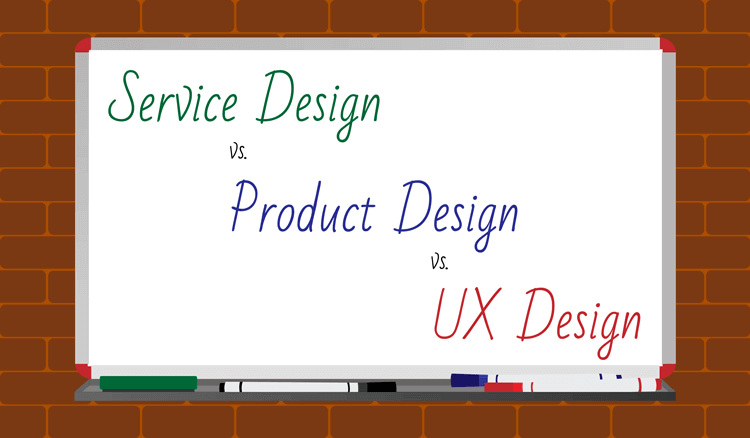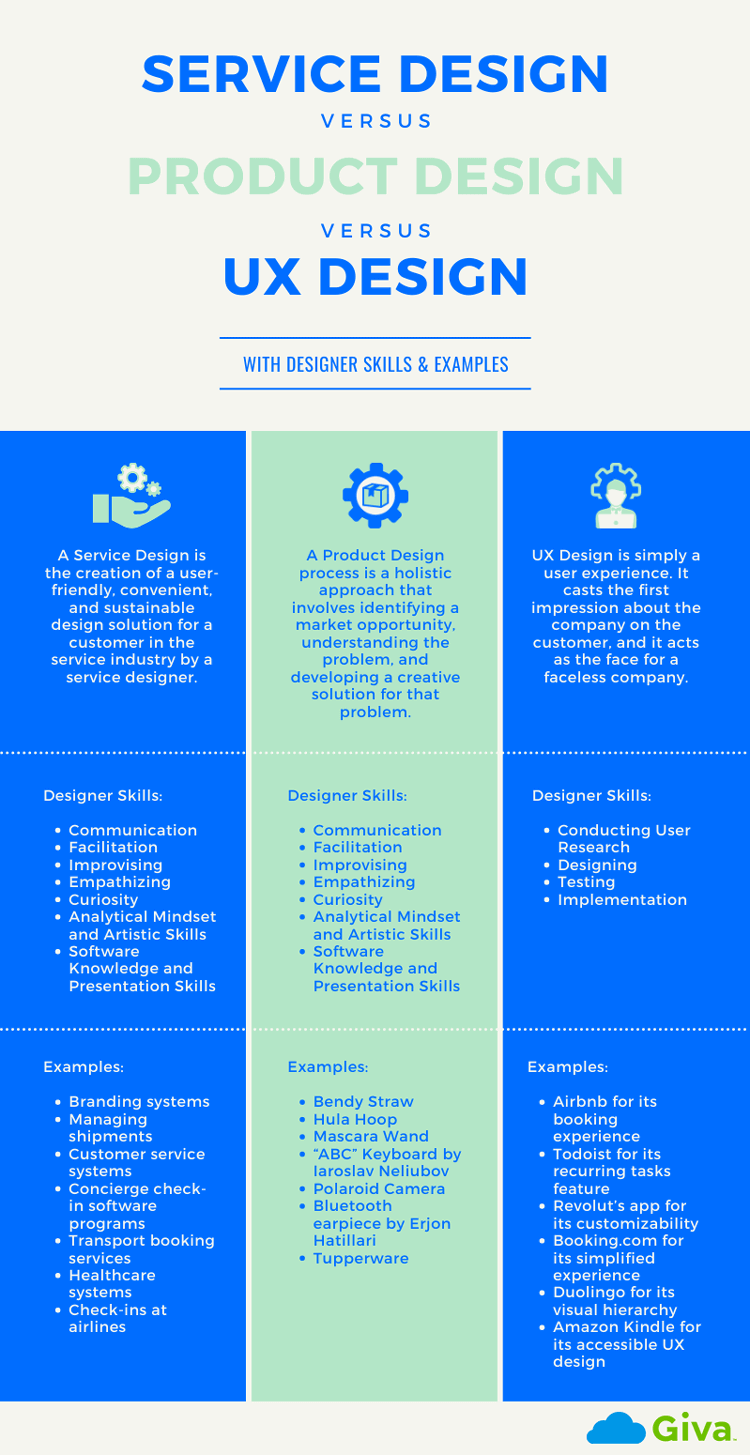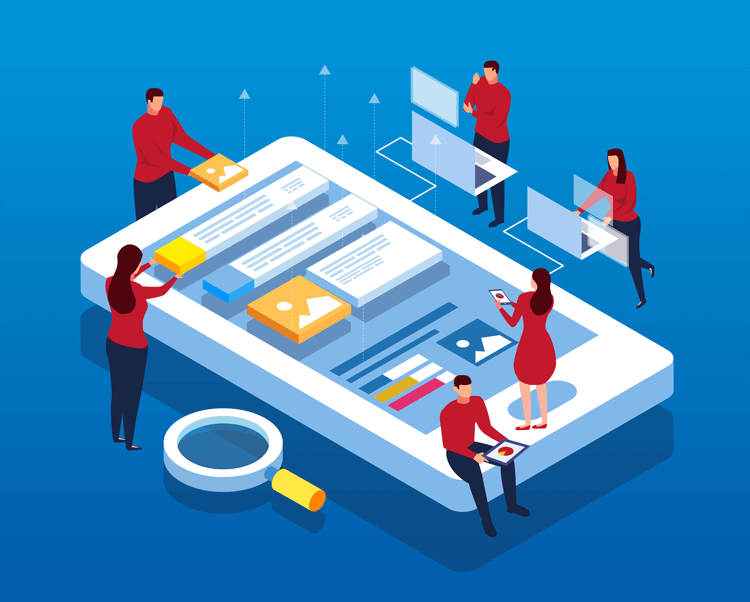Service Design vs. Product Design vs. UX Design, with Designer Skills Required & Examples
Service Design
What is the Importance of Service Design?
The most important reason for the success of a company providing services to its customers is its service design, which is the first point of contact between a company and the customer, and sets the customer's first impression of the company. Did you ever question how air ticketing, hotel booking, or banking services have become so convenient that even a non-technical person can use them easily, or did you ever feel that using one mobile phone service is much easier to use than another? Who makes these services user-friendly and convenient? Well, the answer is a service designer. A service designer is a person entrusted with the role of creation a service design for a company.
What is a Service Design?
A service design is the creating of a user-friendly, convenient, and sustainable design solution for a customer in the service industry by a service designer. If there are two retail stores next to each other in your neighborhood, and they sell the same products with no price difference, then customers are likely to buy from the shop having a better service design. A service designer can best achieve this by dividing services into sections and making appropriate changes to make the service convenient for all customers.
How Should a Service Designer Think to Achieve the Best Service Design?
The service design process involves interaction with as many people as possible, who are relevant to the organization and might use the service. This helps a designer to understand the type of difficulty a customer is facing, which helps to change that area of service. Discussing the problems faced by customers with other researchers, expert designers and reading a lot about the various solutions to a problem can improve the service design process.
Service Design Principles
A service designer should design services:
- According to the demand for the service and genuine need for improvement of the service
- According to customer needs
- Based on feedback received from the users of the service
- By prototyping the services, in order to save time and cost associated with the improvement
- That should deliver a consolidated and productive outcome
- That creates value for its users and customers
- That should be simple yet efficient at the same time.
Service Design Skills
-
Communication
Great communication with co-workers, employees, and clients during a project can make the outcome of the service design more productive. One of the most effective methods of improving communication skills is storytelling.
-
Facilitation
A great designer needs excellent facilitation skills. Facilitation is not only about creating workshops but also about being able to handle a group of talented individuals to work as a team and achieve the best possible outcome for a project in as little time as possible.
-
Improvising
Service design always needs improvement with changing times. If a service designer wants to improve a project, then they should let go of the initial plan and always think out of the box from a customer's point of view to improve an existing one.
-
Empathizing
Some people have a natural ability to learn and see the world from someone else's perspective, but others can eventually develop this skill by being a patient listener and making judgments. Empathy is necessary to understanding customer problems and solving them. This is a skill that yields significant results in a service design process.
-
Curiosity
To become a great service designer, you need a curious mind, as this will benefit a designer from the research stage of a service design. Curiosity is about exploring new things and getting satisfaction from finding answers to new questions. This is an extremely active skill that a service designer needs, as curiosity motivates a person to learn new skills to improve a project design.
-
Analytical Mindset and Artistic Skills
Applying reasoning or logical skills is essential to finding a new product opportunity. A service designer must have an analytical mindset to analyze current market trends or problems associated with an existing product, and an artistic mindset to sketch their initial design ideas through illustration, which can be used later for prototyping.
-
Software Knowledge and Presentation Skills
A service designer must have computer skills, particularly specialized IT skills, like computer-aided design (CAD) and similar computer software programs, to help in designing a product and creating prototypes.
One of the important aspects of service development requires detailed project presentations to clients, or else a client might miss a great product opportunity, and a designer might lose an investor, due to a lack of understanding of the service. Therefore, possessing strong presentation skills is crucial for this role.
Examples of Service Design
Service design is all around you, ranging from check-in kiosks, to the boarding pass at an airline, to the way you order at a restaurant. A few of the service design examples are as follows:
- Branding systems
- Managing shipments
- Customer service systems
- Concierge check-in software programs
- Transport booking services
- Healthcare systems
- Check-ins at airlines

Product Design
Why is Product Design Important?
Just branding a product is not enough, as a consumer will have a variety of products to select from. When all available options offer the same benefits, it is the product design that is innovative, creative, and distinctive that decides the winner. To stand out in a competitive market, a product needs to be well designed, which starts with product packaging.
What is Product Design?
If service design is all about designing services, then what is product design? A product design process is a holistic approach that involves identifying a market opportunity, understanding the problem, and developing a creative solution for that problem. Product designers can be referred to by many names, such as Experience Architect or Interaction Designer, but in simple terms, a product designer can be called a problem solver.
Product design focuses on designing products that provide solutions to a problem by considering customer demand and business goals. Product design can involve creating products or improving an existing design product.
To design a product, a product designer must attempt to solve genuine problems, understand their potential customers' needs, behaviors, and habits and apply a designer's knowledge and empathy to design a product. Consistency and evolution are important factors in a product design process that product designers should consider to keep a product relevant to the future market.
Product Design Principles and Skills Required
The product design principles and skills required by a product designer are the same as that of service design, except that the outcome will be a product and not a service.
Service Design vs. Product Design
A service is mostly regarded as non-tangible, and the customer does not have complete ownership of the service. Service designs are customer-centered, and they add value to the customer only when they are using the service. The steps in designing, the skills required, and the factors to be considered for service design and product design are more or less the same, except that a service designer designs a service.
On the other hand, product design deals with developing a product that is tangible and can be owned by a user. Products have a longer life than a service, and it is much easier to return a product than a service, as services have to be consumed when they are offered. The products are usually physical and sometimes digital.
Examples of Product Design
- Bendy Straw
- Hula Hoop
- Mascara Wand
- "ABC" Keyboard by Iaroslav Neliubov
- Polaroid Camera
- Bluetooth earpiece by Erjon Hatillari
- Tupperware
UX Design
What is the Importance of UX Design?
In today's world where there are so many competitors offering similar products or services, it has become difficult to attract a customer to use your service or product unless, of course, if you are a monopoly on the market for the product. But if you want your product to stand out in your niche, then there are several factors that need to be considered to outperform, and user experience design is a major factor. A user experience design casts the first impression about the company on the customer, and it acts as the face for a faceless company.
What is UX Design?
There is no commonly-accepted definition for user experience design. Design UX is simply a user experience. The role of a user experience designer is to design a project that focuses on providing relevant and pleasant experiences to users. The goal of a user experience designer in a company is to create loyal customers, enhance customer satisfaction, and make sure customers find value in its services. User experience design includes many steps and disciplines to be followed, from creation to integration of a project.
What is a UX Designer, and What Does a UX Designer Do?
We can consider a user experience designer as a bridge between the goal and the development team. The goal can include designing a brand new product or adding a new feature, or changing an existing product or service. The role of a user experience designer does not include designing the visual aspect of the product, but creating user designs for a company that focuses on the journey that the customer takes and on how the product helps with this journey.
Before considering a career as a UX designer, you should be familiar with your role as a designer, the projects that will be offered, and your role in the company. The projects offered to a UX designer may vary depending on the size of the company and the demographic of the customers. The role of a user experience designer involves elements of analysis, assessment, market analysis, wireframing and prototyping.
The specialist roles that come under the title of a designer are as follows:
- User Experience Strategist
- UX Analyst
- UX Writer
- UX Architect / Information Architect
- User Experience Researcher
What are UX Designer Roles?
There are some general functions that a company expects a UX designer to perform, as the following:
-
Conducting User Research
User research involves taking feedback from real users about your product or similar products(if you do not have your product) and finding out what they expect from your platform. A designer usually adopts several methods in order to conduct user research, that includes persona creation, group discussion, questionnaires, and online surveys,
-
Designing
During the design phase, a designer will focus on the functionality and usability of the project, rather than colors or pictures. As a UX designer, your goal is to make the design of the project user-friendly, enjoyable, and ensure that it meets the needs of the business and aligns with the CEO's vision.
-
Testing
Testing the design by wireframing and prototyping is a great way to eliminate user problems or difficulties, and allows you to determine whether the changes made to it in the previous stages meet expectations. Testing includes A/B and usability testing, which can be repeated at any stage, and is aimed at fixing any errors and improving the design quality.
-
Implementation
Implementation is a crucial phase in the role of a UX designer. In this phase, you will work closely with developers to achieve your project's goals. Your interaction with the developer plays a big role in transforming your design ideas into a real, working outcome. As a UX designer will have the final vision of what the developers are expected to produce, guiding a developer constantly throughout the process will make this last phase easier.
The skills required for a product design are like those of service design. Usually, a UX designer handles the entire process. But larger companies divide this role into smaller roles to distribute the workload.
The Best UX Design Examples
- Airbnb for its booking experience
- Todoist for its recurring tasks feature
- Revolut's app for its customizability
- Booking.com for its simplified experience
- Duolingo for its visual hierarchy
- Amazon Kindle for its accessible UX design

Conclusion
To wrap up, the basic skills required and the role of a service designer, product designer, and UX designer are generally the same, and for that reason, people often mistake one role with the other. New ideas and principles of working can make you the best designer in the industry. The design industry is booming, and to qualify as a capable designer, you must have multiple skill sets and the curious mindset of a designer.
It is basic human nature to seek improvement in any aspect of life, whether it is the design of a product or the product itself. This quality in a human being to seek evolution will always ensure that the role of a designer in a market will never cease to exist. New specializations are always created in a company under the umbrella of a designer, thus a curious and creative mind will always be required.





